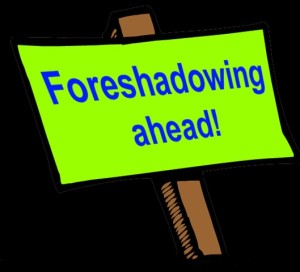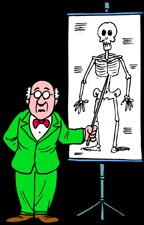By Joe Moore
HAPPY SAINT PATRICK’S DAY!
A few weeks ago we discussed flashbacks and how they allow writers to convey backstory while the scene usually remains in the present. It’s a common technique in the writer’s toolbox for filling in the important history of a character or other elements in the story.
 Today’s post is about foreshadowing, a technique that also deals with time. Most writers are familiar with it although few know about a companion technique called backshadowing. Both work well when used discretely.
Today’s post is about foreshadowing, a technique that also deals with time. Most writers are familiar with it although few know about a companion technique called backshadowing. Both work well when used discretely.
Let’s start with foreshadowing. It’s the planting of hints and clues that tip off the reader as to what may come later in the story. For example, a character who is destined to die in an automobile accident 10 pages from now could complain about the unusual icy condition of the roads as the weather gets worse.
This technique can add dramatic tension by building anticipation about what might happen later. Foreshadowing can be used to generate suspense or to get across information that helps the reader appreciate future developments. Foreshadowing can also help make believable what might otherwise be outlandish or extraordinary events. For instance, if something in a character’s background is foreshadowed (she’s afraid of heights), then the reader will be prepared when a set of circumstances occur that cause a character to panic while standing on a roof.
There are many types of foreshadowing including direct, subtle, atmospheric, and global.
Direct foreshadowing is just that; a direct piece of information that is revealed to the reader about a future event.
Her plan was to pick the lock on the rear entrance, disable the alarm and disconnect the camera feeds before grabbing the jewels.
Subtle foreshadowing is not so obvious. It can be small crumbs of information that, when added together, help believability.
He reached for the red coffee cup but hesitated, knowing that particular color always meant failure.
Atmospheric foreshadowing usually deals with the elements surrounding the character and how they might reflect a mood or situation.
She crouched behind the wall and watched the clouds move across the moon and blot out the stars. The darkness would bring death.
Global foreshadowing is usually found right up front, either at the beginning of the book or the start of a chapter.
It never occurred to him that by the end of the day, he would shoot and kill five people.
So if that’s foreshadowing, what the heck is backshadowing?
It’s usually an event that has already occurred but affects the future. A Salem witch is burnt at the stake on page 15, while hundreds of years and many pages later, a woman comments that her new Salem, Mass apartment has a lingering burning smell.
Another common use of backshadowing is to start the story with the ending, then shift back to the beginning with the reader in full knowledge of the outcome but no idea how it all happened.
That’s how I wound up dead on a beautiful fall evening. But I’m getting ahead of myself. Let’s back up and start at the beginning . . .
The reader doesn’t have to spot the foreshadowing or backshadowing when they occur, but they should be able to see their significance later.
Do you use either or both in your writing? Can you think of other types of foreshadowing and how they’re used?
Download FRESH KILLS, Tales from the Kill Zone to your Kindle or PC today.

 rs ago but hasn’t made much progress.
rs ago but hasn’t made much progress. – and realized that they’d only made it through a tiny portion of the entire trail. At that point they flew home, took a break, and met up again later in Virginia, skipping a huge chunk of the hike.
– and realized that they’d only made it through a tiny portion of the entire trail. At that point they flew home, took a break, and met up again later in Virginia, skipping a huge chunk of the hike.



